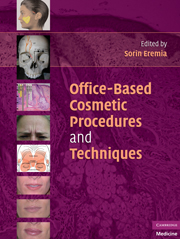Book contents
- Frontmatter
- Contents
- PREFACE
- CONTRIBUTORS
- PART ONE ANATOMY AND THE AGING PROCESS
- PART TWO ANESTHESIA AND SEDATION FOR OFFICE COSMETIC PROCEDURES
- PART THREE FILLERS AND NEUROTOXINS
- PART FOUR COSMETIC APPLICATIONS OF LIGHT, RADIOFREQUENCY, AND ULTRASOUND ENERGY
- Chap. 42 TREATMENT OF TELANGIECTASIA, POIKILODERMA, AND FACE AND LEG VEINS
- Chap. 43 VASCULAR LASERS
- Chap. 44 OVERVIEW OF CO2 AND ER:YAG LASERS AND PLASMA DEVICES
- Chap. 45 CONTEMPORARY CO2 LASER RESURFACING
- Chap. 46 ER:YAG
- Chap. 47 PLASMA SKIN REJUVENATION OF THE HANDS
- Chap. 48 NONABLATIVE LASER TISSUE REMODELING: 1,064-, 1,320-, 1,450-, AND 1,540-NM LASER SYSTEMS
- Chap. 49 OVERVIEW OF BROADBAND LIGHT DEVICES
- Chap. 50 TITAN: INDUCING DERMAL CONTRACTION
- Chap. 51 SCITON BROADBAND LIGHT AND ER:YAG MICROPEEL COMBINATION
- Chap. 52 AMINOLEVULINIC ACID PHOTODYNAMIC THERAPY FOR FACIAL REJUVENATION AND ACNE
- Chap. 53 THERMAGE FOR FACE AND BODY
- Chap. 54 LUMENIS ALUMA SKIN TIGHTENING SYSTEM
- Chap. 55 ELLMAN RADIOFREQUENCY DEVICE FOR SKIN TIGHTENING
- Chap. 56 ALMA ACCENT DUAL RADIOFREQUENCY DEVICE FOR TISSUE CONTOURING
- Chap. 57 COMBINED LIGHT AND BIPOLAR RADIOFREQUENCY
- Chap. 58 FRACTIONAL LASERS: GENERAL CONCEPTS
- Chap. 59 PALOMAR LUX 1,540-NM FRACTIONAL LASER
- Chap. 60 FRAXEL 1,550-NM LASER (FRAXEL RE:STORE)
- Chap. 61 1,440-NM FRACTIONAL LASER: CYNOSURE AFFIRM
- Chap. 62 SCITON ER:YAG 2,940-NM FRACTIONAL LASER
- Chap. 63 ALMA PIXEL ER:YAG FRACTIONAL LASER
- Chap. 64 FRACTIONATED CO2 LASER
- Chap. 65 LED PHOTOREJUVENATION DEVICES
- Chap. 66 PHOTOPNEUMATIC THERAPY
- Chap. 67 HAIR REMOVAL: LASER AND BROADBAND LIGHT DEVICES
- Chap. 68 ACNE AND ACNE SCARS: LASER AND LIGHT TREATMENTS
- Chap. 69 FAT AND CELLULITE REDUCTION: GENERAL PRINCIPLES
- Chap. 70 ULTRASHAPE FOCUSED ULTRASOUND FAT REDUCTION DEVICE
- Chap. 71 LIPOSONIX ULTRASOUND DEVICE FOR BODY SCULPTING
- PART FIVE OTHER PROCEDURES
- INDEX
- References
Chap. 68 - ACNE AND ACNE SCARS: LASER AND LIGHT TREATMENTS
from PART FOUR - COSMETIC APPLICATIONS OF LIGHT, RADIOFREQUENCY, AND ULTRASOUND ENERGY
Published online by Cambridge University Press: 06 July 2010
- Frontmatter
- Contents
- PREFACE
- CONTRIBUTORS
- PART ONE ANATOMY AND THE AGING PROCESS
- PART TWO ANESTHESIA AND SEDATION FOR OFFICE COSMETIC PROCEDURES
- PART THREE FILLERS AND NEUROTOXINS
- PART FOUR COSMETIC APPLICATIONS OF LIGHT, RADIOFREQUENCY, AND ULTRASOUND ENERGY
- Chap. 42 TREATMENT OF TELANGIECTASIA, POIKILODERMA, AND FACE AND LEG VEINS
- Chap. 43 VASCULAR LASERS
- Chap. 44 OVERVIEW OF CO2 AND ER:YAG LASERS AND PLASMA DEVICES
- Chap. 45 CONTEMPORARY CO2 LASER RESURFACING
- Chap. 46 ER:YAG
- Chap. 47 PLASMA SKIN REJUVENATION OF THE HANDS
- Chap. 48 NONABLATIVE LASER TISSUE REMODELING: 1,064-, 1,320-, 1,450-, AND 1,540-NM LASER SYSTEMS
- Chap. 49 OVERVIEW OF BROADBAND LIGHT DEVICES
- Chap. 50 TITAN: INDUCING DERMAL CONTRACTION
- Chap. 51 SCITON BROADBAND LIGHT AND ER:YAG MICROPEEL COMBINATION
- Chap. 52 AMINOLEVULINIC ACID PHOTODYNAMIC THERAPY FOR FACIAL REJUVENATION AND ACNE
- Chap. 53 THERMAGE FOR FACE AND BODY
- Chap. 54 LUMENIS ALUMA SKIN TIGHTENING SYSTEM
- Chap. 55 ELLMAN RADIOFREQUENCY DEVICE FOR SKIN TIGHTENING
- Chap. 56 ALMA ACCENT DUAL RADIOFREQUENCY DEVICE FOR TISSUE CONTOURING
- Chap. 57 COMBINED LIGHT AND BIPOLAR RADIOFREQUENCY
- Chap. 58 FRACTIONAL LASERS: GENERAL CONCEPTS
- Chap. 59 PALOMAR LUX 1,540-NM FRACTIONAL LASER
- Chap. 60 FRAXEL 1,550-NM LASER (FRAXEL RE:STORE)
- Chap. 61 1,440-NM FRACTIONAL LASER: CYNOSURE AFFIRM
- Chap. 62 SCITON ER:YAG 2,940-NM FRACTIONAL LASER
- Chap. 63 ALMA PIXEL ER:YAG FRACTIONAL LASER
- Chap. 64 FRACTIONATED CO2 LASER
- Chap. 65 LED PHOTOREJUVENATION DEVICES
- Chap. 66 PHOTOPNEUMATIC THERAPY
- Chap. 67 HAIR REMOVAL: LASER AND BROADBAND LIGHT DEVICES
- Chap. 68 ACNE AND ACNE SCARS: LASER AND LIGHT TREATMENTS
- Chap. 69 FAT AND CELLULITE REDUCTION: GENERAL PRINCIPLES
- Chap. 70 ULTRASHAPE FOCUSED ULTRASOUND FAT REDUCTION DEVICE
- Chap. 71 LIPOSONIX ULTRASOUND DEVICE FOR BODY SCULPTING
- PART FIVE OTHER PROCEDURES
- INDEX
- References
Summary
ACNE
Almost everyone experiences acne. If over-the-counter topical agents are ineffective, physicians prescribe antiacne creams, lotions, and/or gels. In a step-wise approach, stubborn cases are normally treated with oral antibiotics and, finally, by isotretinoin. Despite criticisms leveled against traditional antiacne remedies (i.e., drug resistance with antibiotics), creative dermatologists can usually manage acne using the full range of our present-day drug armamentarium. In fact, most dermatologists do not use light in the treatment of acne. However, all dermatologists encounter patients who either have severe acne that is unresponsive to traditional medications or, more commonly, chronic or intermittent acne that resists most therapies. In these circumstances, light therapy represents a viable treatment option, either as a monotherapy or as a complement to drugs. The following groups are especially good candidates for light: (1) the patient who fails oral antibiotic therapy and is unwilling or unable to tolerate isotretinoin; isotretinoin has been associated with suicide, and although no clear causality has been established, a teenager with volatile depression might undergo a trial of light before considering systemic retinoids; (2) the patient failing topical therapy who is unwilling or unable to take oral antibiotics; light may act as a medication-sparing agent in these cases; (3) a pregnant or nursing patient, or a woman actively trying to conceive; (4) patients sensitive to almost all topical remedies, especially topical retinoids; (5) the patient who resists or is noncompliant on at-home daily drug regimens; and (6) adult females with mild to moderate acne for whom a combination of hormonal therapy (i.e., BCP and possibly spironolactone), oral antibiotics, and topical retinoids has proved only partially effective.
- Type
- Chapter
- Information
- Office-Based Cosmetic Procedures and Techniques , pp. 296 - 308Publisher: Cambridge University PressPrint publication year: 2010

